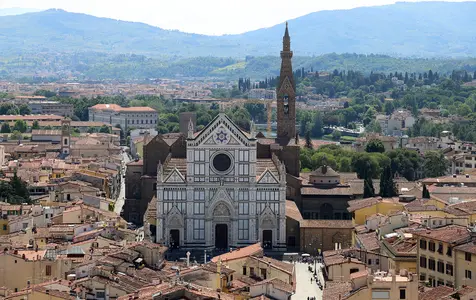The Secrets of Florence, Unraveled
By Diana Roome
 If anyone glimpsed me staring down at the paving stones in the Santa Croce quarter of Florence, Italy, last summer, they might have thought me a little odd. After all, there are so many more attractive things to look out for – from Santa Croce’s Gothic basilica for great art and the tombs of the famous to the celebrated Gelateria Vivoli for the indulgence of the taste buds.
If anyone glimpsed me staring down at the paving stones in the Santa Croce quarter of Florence, Italy, last summer, they might have thought me a little odd. After all, there are so many more attractive things to look out for – from Santa Croce’s Gothic basilica for great art and the tombs of the famous to the celebrated Gelateria Vivoli for the indulgence of the taste buds.
But for me, these well-worn stones held a more interesting secret. They were giving me the opportunity to literally walk in the footsteps of Dante, who held the down-to-earth job of supervisor of public works here in the early 1300s.
I knew this as a result of an Italian history class I was taking in Cupertino, Calif. Our professor would vividly recount to his mostly middle-aged, eager-to-learn students the details of Dante’s life in Firenze (Florence) and his later wanderings in exile. All this came while guiding us through selected chapters of “The Divine Comedy.”
As a result of these weekly classes, I’d become fascinated by people and places from hundreds of years ago and thousands of miles away.
Michelangelo and the poet Petrarch entered my dreams at night and walked beside me during my day.
In fact, the “fab three” – Petrarch, Dante, and Boccaccio – were like rock stars to me.
My newest imaginary friend, Alessandra Strozzi, was a noble Florentine lady whose family’s male members had been exiled by the Medicis in the early 1400s. This matriarch’s letters to her sons are so vivid that I found myself poised to seize a pen and write back to her, offering sympathy and a tentative invitation to stop by for tea.
Inside the Church of Santa Maria Novella, I imagined the dignified Alessandra at mass scoping out marriageable girls suitable for her reluctant sons. I even sympathized with her worries about the barrel of highly perishable plums she’d sent to them in Naples from the family farm outside Florence.
Through the skills of a gifted teacher, I’d learned to feel the pain and pleasures of Signora Strozzi and the ordinary citizens of Florence who were living through extraordinary times.
I had tuned into the lives of people I’d once only known by their names – Piero della Francesca, Lorenzo de’ Medici, Nicolo Machiavelli, and Pico della Mirandola.
I’d been to Italy several times, but after my class, I arrived like a sleuth. I had lecture notes in my suitcase along with summer clothes – and scores of questions to be answered.
I wanted to see for myself the streets where Michelangelo played as a boy and the Pazzi Chapel where he studied Giotto’s frescoes.
In Santa Maria del Carmine, south of the Arno, I saw that Masaccio’s frescoes are as fresh (since restoration) as if they had been completed a month ago. But this time I knew where to find the painter’s brooding self-portrait (gazing out at us to the right of the boy raised from the dead by St. Peter). His face is so strong, so certain of itself that I wondered about the cause of Masaccio’s sudden departureto Rome, and his death at just 27.
A budding understanding of this painter’s importance in the progress of art drew me on to see his bold, brilliant experiment in perspective, the “Trinity,” at Santa Maria Novella.
Between these two points, I walked beneath the arch under which the goldsmith and sculptor Benvenuto Cellini, in a fit of frustration with his domineering father, tried to run away to Rome. In his autobiography, he said he took the wrong gate through the city’s formidable walls and ended up walking to Pisa instead.
Later, climbing the 463 steps between the two shells of the Duomo’s daring dome, I looked for the little niches Brunelleschi planned in the dome’s interior for food vendors to set up stalls so that laborers would not have to descend hundreds of steps to get their lunches.
The architect took decades to build this huge edifice against initial opposition and near-impossible challenges. But the human details – his worries about his workmen and the effects of wind – seemed especially poignant now that I knew about his pride, irascibility, and irrepressible creativity.
Understanding a little about the quests that animated its citizens’ lives brought the stones of Florence alive for me. I felt the time dimension shrink to a point where centuries seem to evaporate enough to catch an imagined glimpse of people I’d met in lectures and readings.
Italy is a saga of marvels. You can love it without knowing anything beyond what your guidebook tells you. But there is an extra frisson of excitement in slipping out of the tourist mind-set, going back in time, and entering the lives of those who gave the country its extraordinary history.
For me, Florence came alive anew in light of its history, which explains how some of the greatest ideas, art, and architecture the world has ever seen came to be forged in a white heat of creative innovation.
For the investment of a few months of study, any place can buzz with the voices of the past as well as the present.
Now that I’ve heard those echoes, I’ll be seeking out this hidden dimension wherever I travel.
